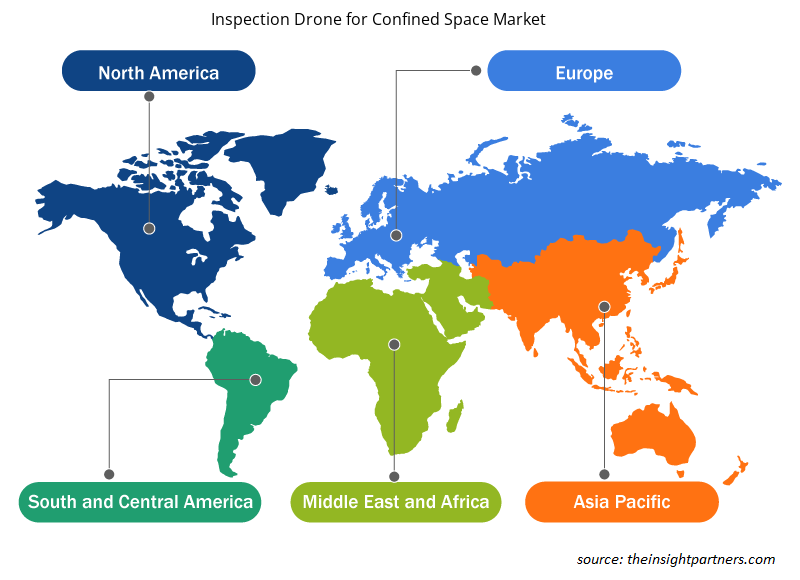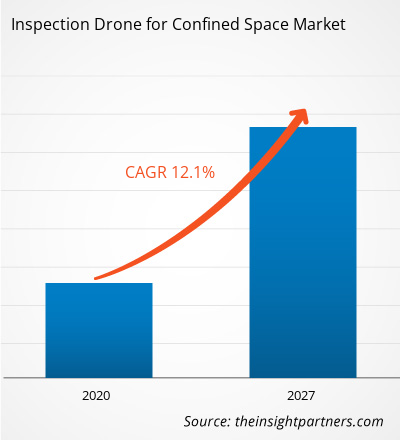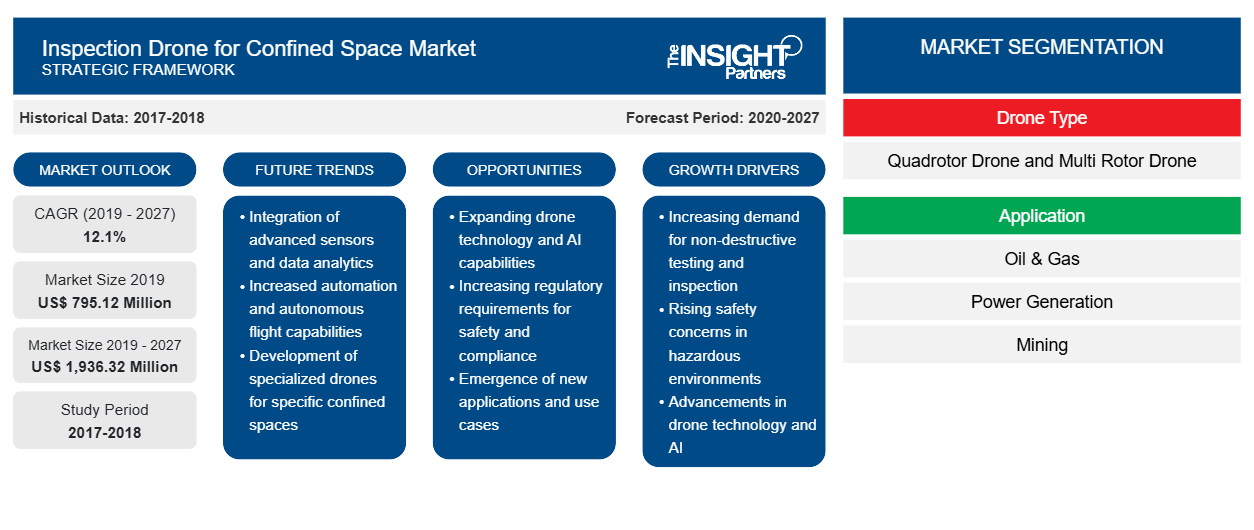Der Markt für Inspektionsdrohnen für beengte Räume hatte im Jahr 2019 einen Wert von 795,12 Millionen US-Dollar und soll bis 2027 einen Wert von 1.936,32 Millionen US-Dollar erreichen; im Prognosezeitraum 2020 bis 2027 dürfte er mit einer durchschnittlichen jährlichen Wachstumsrate von 12,1 % wachsen.
Die Inspektion von beengten Bereichen ist teuer, zeitaufwändig und birgt manchmal Lebensgefahr. Daher gewinnt die Verwendung von Drohnen zur Inspektion beengter Bereiche in verschiedenen Anwendungen enorm an Bedeutung. Darüber hinaus bieten diese Drohnen den Benutzern weitere Vorteile, da sie zusätzliche Funktionen bieten, wie z. B. die Installation von IR-Kameras, die erweiterte visuelle und Datenanalysefunktionen bieten und die Bewertung des tatsächlichen Anlagenzustands und des Wartungsbedarfs ermöglichen. Es wird erwartet, dass Drohnen in verschiedenen Inspektionsanwendungen eine wichtige Rolle spielen, die die 4D-Kriterien erfüllen: Schmutz, Staub, Entfernung und Stumpfheit. Angesichts des steigenden Kostendrucks bei Industriedienstleistungsunternehmen und Anlagenbetreibern optimieren Inspektionen mit Drohnen die Zeit und sparen Kosten sowie die Qualität und Leistung. Mit diesen Vorteilen helfen Inspektionsdrohnen für beengte Räume Unternehmen, einen Wettbewerbsvorteil zu sichern.
Passen Sie diesen Bericht Ihren Anforderungen an
Sie erhalten kostenlos individuelle Anpassungen an jedem Bericht, einschließlich Teilen dieses Berichts oder einer Analyse auf Länderebene, eines Excel-Datenpakets sowie tolle Angebote und Rabatte für Start-ups und Universitäten.
-
Holen Sie sich die wichtigsten Markttrends aus diesem Bericht.Dieses KOSTENLOSE Beispiel umfasst eine Datenanalyse von Markttrends bis hin zu Schätzungen und Prognosen.
Auswirkungen der COVID-19-Pandemie auf den Markt für Inspektionsdrohnen für beengte Räume
Die COVID-19-Pandemie hat die Lieferkettenaktivitäten deutlich gestört und die Nachfrage nach Inspektionsdrohnen in mehreren Branchen stark einbrechen lassen. Faktoren wie Beschränkungen beim Import und Export von Waren und Herausforderungen beim Transport aufgrund der landesweiten Ausgangssperren in mehreren Ländern sowie die vorübergehende Einstellung von Produktions- und Fertigungsaktivitäten haben insgesamt zu einem Rückgang der Nachfrage nach Inspektionsdrohnen geführt. Die gesamte Drohnenbranche verzeichnet jedoch in den letzten Jahren Wachstumschancen in Anwendungen wie Überwachung, Überwachung, Lieferung und Desinfektionsaktivitäten. Darüber hinaus wird erwartet, dass der Markt für Inspektionsdrohnen für beengte Räume in den kommenden Monaten an Dynamik gewinnt, da verschiedene Regierungen Schritte und Reformen zur Wiederbelebung der allgemeinen Wirtschaftsaktivitäten in Erwägung ziehen.
Einblicke in den Markt für Inspektionsdrohne für beengte Räume
Reduzierte Wartungskosten
Der Aufbau eines Gerüsts zur Durchführung manueller Inspektionen ist ein kostspieliger Prozess; außerdem gelingt es bei manuellen Inspektionen oft nicht, das genaue Problem zu finden, das behoben werden muss.Durch den Einsatz von Drohnen zur Inspektion können Unternehmen die tatsächlichen Wartungskosten um bis zu 80–90 % senken. Außerdem sind Drohnen mit Sensoren ausgestattet, um andere Aufgaben als nur visuelle Inspektionen durchzuführen. Eine landwirtschaftliche Drohne für den Einsatz in der Indoor-Landwirtschaft ist beispielsweise mit Multispektralsensoren ausgestattet, mit denen Landwirte Bilder von Pflanzen in unterschiedlichen Spektralbändern aufzeichnen können. Darüber hinaus hilft der Einbau einer Wärmebildkamera in Drohnen für HVAC-Inspektionen dabei, Wärmelecks in einem Gebäude zu identifizieren.
Markteinblicke basierend auf Drohnentypen
Inspektionen sind eine wichtige Anwendung von Drohnen. Die Auswahl der Drohne unterscheidet sich jedoch von Branche zu Branche, je nach Komplexität der Aufgabe. Basierend auf dem Drohnentyp wird der Markt für Inspektionsdrohnen für beengte Räume weiter unterteilt in Quadrotor-Drohnen und Multirotor-Drohnen. Quadrotor-Drohnen, allgemein bekannt als Quadcopter, können in jede Richtung fliegen und schweben auch problemlos an jedem beliebigen Ort. Obwohl sich das Steuerungssystem zwischen Quadrotoren und Hubschraubern aufgrund der Flugdynamik erheblich unterscheidet, können Quadrotoren ähnlich wie Hubschrauber vertikale Starts und Landungen durchführen. Ein Quadrotor ist mit vier Rotorarmen ausgestattet und in verschiedenen Größen erhältlich. Er kann auch kleinere Nutzlasten tragen, z. B. eine Kamera. Sie werden häufig für Inspektionsvorgänge in Energieanlagenbereichen wie Ölraffinerien, Baustellen und im Bergbau eingesetzt.
AnwendungsbasierteMarkteinblicke
Inspektionsaufgaben in engen Räumen in verschiedenen Branchen wie Öl und Gas, Bauwesen und Schifffahrt können schwierig, zeitaufwändig, gefährlich und teuer sein. Darüber hinaus können enge Räume für Menschen gefährlich sein. Auch eingeschränkte Zugänglichkeit und Sicht können die Fähigkeit des Inspektors einschränken, enge Räume effektiv und umfassend zu inspizieren. Unternehmen auf der ganzen Welt nutzen Roboter, darunter Drohnen, um verschiedene enge Räume in ihren Anlagen, darunter Tanks, Kessel, Rohre, Tunnel und Schornsteine, sicher zu inspizieren. Drohnen helfen, Zeit und Kosten für Ausrüstung und Arbeitskräfte zu reduzieren und gleichzeitig die Risikofaktoren für menschliche Arbeiter zu senken.
Die Akteure auf dem Markt für Inspektionsdrohnen für beengte Räume konzentrieren sich auf Strategien wie Marktinitiativen, Akquisitionen und Produkteinführungen, um ihre Positionen auf dem Markt zu behaupten. Nachfolgend sind einige Entwicklungen der wichtigsten Akteure aufgeführt:
Im Jahr 2020 schloss MFE Enterprises, Inc. eine Vereinbarung zur Ausweitung des US-Territoriums ab, im Rahmen derer die Drohnen Elios und Elios 2 von Flyability verkauft werden sollen. Die Vereinbarung gewährt MFE Enterprises das exklusive Recht, die kollisionstoleranten Drohnen von Flyability für Inspektionen und Überwachungen in den 11 US-Bundesstaaten zu verkaufen.
Im Jahr 2019 brachte Digital Aerolus ein neues UAV namens Aertos 130IR für Inspektionen im Bergbau, in der Infrastruktur und bei Kraftwerken auf den Markt. Die Drohne nutzt KI und patentierte autonome Technologie, um ohne GPS oder externe Sensoren fliegen zu können.
Inspektionsdrohne für beengte Räume Marktregionale Einblicke
Die regionalen Trends und Faktoren, die den Markt für Inspektionsdrohnen für beengte Räume während des gesamten Prognosezeitraums beeinflussen, wurden von den Analysten von Insight Partners ausführlich erläutert. In diesem Abschnitt werden auch Marktsegmente und Geografien für Inspektionsdrohnen für beengte Räume in Nordamerika, Europa, im asiatisch-pazifischen Raum, im Nahen Osten und Afrika sowie in Süd- und Mittelamerika erörtert.

- Erhalten Sie regionale Daten zum Markt für Inspektionsdrohnen für beengte Räume
Umfang des Marktberichts „Inspektionsdrohne für beengte Räume“
| Berichtsattribut | Details |
|---|---|
| Marktgröße im Jahr 2019 | 795,12 Millionen US-Dollar |
| Marktgröße bis 2027 | 1.936,32 Millionen US-Dollar |
| Globale CAGR (2019 - 2027) | 12,1 % |
| Historische Daten | 2017-2018 |
| Prognosezeitraum | 2020–2027 |
| Abgedeckte Segmente |
Nach Drohnentyp
|
| Abgedeckte Regionen und Länder |
Nordamerika
|
| Marktführer und wichtige Unternehmensprofile |
|
Dichte der Marktteilnehmer für Inspektionsdrohnen für beengte Räume: Verständnis ihrer Auswirkungen auf die Geschäftsdynamik
Der Markt für Inspektionsdrohnen für beengte Räume wächst rasant, angetrieben durch die steigende Nachfrage der Endnutzer aufgrund von Faktoren wie sich entwickelnden Verbraucherpräferenzen, technologischen Fortschritten und einem größeren Bewusstsein für die Vorteile des Produkts. Mit steigender Nachfrage erweitern Unternehmen ihr Angebot, entwickeln Innovationen, um die Bedürfnisse der Verbraucher zu erfüllen, und nutzen neue Trends, was das Marktwachstum weiter ankurbelt.
Die Marktteilnehmerdichte bezieht sich auf die Verteilung der Firmen oder Unternehmen, die in einem bestimmten Markt oder einer bestimmten Branche tätig sind. Sie gibt an, wie viele Wettbewerber (Marktteilnehmer) in einem bestimmten Marktraum im Verhältnis zu seiner Größe oder seinem gesamten Marktwert präsent sind.
Die wichtigsten Unternehmen auf dem Markt für Inspektionsdrohnen für beengte Räume sind:
- Digitaler Aerolus
- Drohnenvolt
- Flyability SA
- Imaze Tech Ltd.
- Interactive Aerial, Inc.
Haftungsausschluss : Die oben aufgeführten Unternehmen sind nicht in einer bestimmten Reihenfolge aufgeführt.

- Überblick über die wichtigsten Akteure auf dem Markt für Inspektionsdrohnen für beengte Räume
Markt für Inspektionsdrohne für beengte Räume – nach Typ
- Quadrotor-Drohne
- Multirotor-Drohne
Inspektionsdrohne für den Markt für beengte Räume – nach Anwendung
- Öl und Gas
- Stromerzeugung
- Bergbau
- Chemikalien
- Seeschiffe
- Sonstiges
Inspektionsdrohne für den Markt für beengte Räume – nach Geografie
-
Nordamerika
- UNS
- Kanada
- Mexiko
-
Europa
- Deutschland
- Frankreich
- Italien
- Vereinigtes Königreich
- Russland
- Restliches Europa
-
Asien-Pazifik (APAC)
- Australien
- China
- Indien
- Japan
- Südkorea
- Restlicher Asien-Pazifik-Raum
-
Naher Osten und Afrika (MEA)
- Saudi-Arabien
- Vereinigte Arabische Emirate
- Südafrika
- Rest von MEA
-
Südamerika (SAM)
- Brasilien
- Argentinien
- Rest von SAM
Inspektionsdrohne für den Markt für beengte Räume – Firmenprofile
- Digitaler Aerolus
- Drohnenvolt
- Flyability SA
- Imaze Tech Ltd.
- Interactive Aerial, Inc.
- Multinov
- Performance Rotors Pte. Ltd.
- Scout Drone Inspection AS
- Skypersonic Inc
- Terra Drone Corp.
- Historische Analyse (2 Jahre), Basisjahr, Prognose (7 Jahre) mit CAGR
- PEST- und SWOT-Analyse
- Marktgröße Wert/Volumen – Global, Regional, Land
- Branchen- und Wettbewerbslandschaft
- Excel-Datensatz
Aktuelle Berichte
Verwandte Berichte
Erfahrungsberichte
Grund zum Kauf
- Fundierte Entscheidungsfindung
- Marktdynamik verstehen
- Wettbewerbsanalyse
- Kundeneinblicke
- Marktprognosen
- Risikominimierung
- Strategische Planung
- Investitionsbegründung
- Identifizierung neuer Märkte
- Verbesserung von Marketingstrategien
- Steigerung der Betriebseffizienz
- Anpassung an regulatorische Trends























 Kostenlose Probe anfordern für - Inspektionsdrohne für den Markt für beengte Räume
Kostenlose Probe anfordern für - Inspektionsdrohne für den Markt für beengte Räume